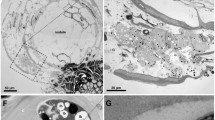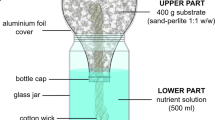Summary
A microaerobic diazotrophic bacterium tentatively identified as aPseudomonas species was isolated from a forest soil. Its nitrogenase (C2H2 reduction) activity in liquid medium was significantly supported by phenolic compounds when compared with glucose-, mannitol- or malate-supported activity. The utilization of phenolics was dependent on substrate induction and the appropriate oxygen concentration. At a pO2 of 0.05 protocatechuate was a better carbon source for N2 fixation than glucose. In the case ofLignobacter protocatechuate was a better carbon source for N2 fixation than glucose at pO2 0.2 but not at pO2 0.05. It is suggested that certain monomeric phenols can support nitrogenase activities in many carbon-limited soil environments.
Similar content being viewed by others
References
Balandreau J 1983 Microbiology of the association. Can J. Microbiol. 29, 851–859.
Barraquio W L, Ladha J K and Watanabe I 1983 Isolation and identification of N2-fixingPseudomonas associated with wetland rice. Can. J. Microbiol. 29, 867–873.
Chen Y P, Glenn A R and Dilworth M J 1984 Uptake and oxidation of aromatic substances byRhizobium leguminosarum MNF 3841 andRhizobium trifolii TA1. FEMS Microbiol. Lett. 21, 201–205.
Dalton H 1980 The cultivation of diazotrophic microorganisms.In Methods of Evaluating Biological Nitrogen Fixation. Ed. F J Bergersen. John Wiley & Sons Ltd., New York, pp 13–64.
De Smedt J and De Ley J 1977 Intra- and intergeneric similarities ofAgrobacterium ribosomal ribonucleic acid cistrons. Int. J. Sys. Bacteriol. 30, 106–122.
Flaig W 1971 Organic compounds in soil. Soil Sci. 111, 19–33.
Grant M A and Holt J G 1977 Medium for the selective isolation of members of the genusPseudomonas from natural sources. Appl. Environ. Microbiol. 33, 1222–1224.
Haahtela K, Helander I, Nurmiaho-Lassila E-L and Sundman V 1983 Morphological and physiological characteristics and lipopolysaccharide composition of N2-fixing (C2H2-reducing) root-associatedPseudomonas sp. Can. J. Microbiol. 29, 874–880.
Haider K, Martin J P and Filip Z 1975 Humus biochemistry.In Soil Biochemistry, Vol. 4. Eds E A Paul and A D McLaren. Marcel Dekker, New York, pp 195–244.
Hardisson C, Sala-Trepat J M and Stanier R Y 1969 Pathways for the oxidation of aromatic compounds byAzotobacter. J. Gen. Microbiol. 59, 1–11.
Kersters K and De Ley J 1984Alcaligenes.In Bergey's Manual, of Systematic Bacteriology, Vol. 1. Eds N R Krieg and J G Hold. Williams & Wilkins, Baltimore, pp 361–373.
Lowry O H, Rosebrough N J, Farr O L and Randall R J 1951 Protein measurement with the Folin phenol reagent. J. Biol. Chem. 193, 265–275.
Palleroni N J 1984Pseudomonas.In Bergey's Manual of Systematic Bacteriology, Vol. 1. Eds N R Krieg and J G Holt. Williams & Wilkins, Baltimore, pp 141–199.
Postgate J R 1982 Biological nitrogen fixation: fundamentals. Phil. Trans., R. Soc. London, Ser. B 296, 343–361.
Salkinoja-Salonen M S, Väisänen E and Paterson A 1979 Involvement of plasmids in the bacterial degradation of lignin-derived compounds.In Plasmids of Medical, Environmental and Commercial Importance. Eds K N Timmis and A Puhler. Elsevier/North-Holland Biomedical Press, Amsterdam, pp 301–314.
Stanier R Y, Palleroni N J and Doudoroff M 1966 The aerobic pseudomonads: a taxonomic study. J. Gen. Microbiol. 43, 159–271.
Stolp H and Gadkari D 1981 Nonpathogenic members of the genusPseudomonas.In The Prokaryotes, Vol. 1. Eds M P Starr, H Stolp, H G Truper, A Balows and H G Schlegel. Springer-Verlag, Berlin, pp 719–741.
Sundman V 1964 A description of some lignanolytic soil bacteria and their ability to oxidize simple phenolic compounds. J. Gen. Microbiol. 36, 171–183.
Whitehead D C, Dibb H and Hartley R D 1983 Bound phenolic compounds in water extracts of soils, plant roots and leaf litter. Soil Biol. Biochem. 15, 133–136.
Author information
Authors and Affiliations
Additional information
Contribution No. 1484 from the Chemistry and Biology Research Institute, Agriculture Canada, Ottawa, Canada.
Rights and permissions
About this article
Cite this article
Chan, YK. Utilization of simple phenolics for dinitrogen fixation by soil diazotrophic bacteria. Plant Soil 90, 141–150 (1986). https://doi.org/10.1007/BF02277393
Issue Date:
DOI: https://doi.org/10.1007/BF02277393




